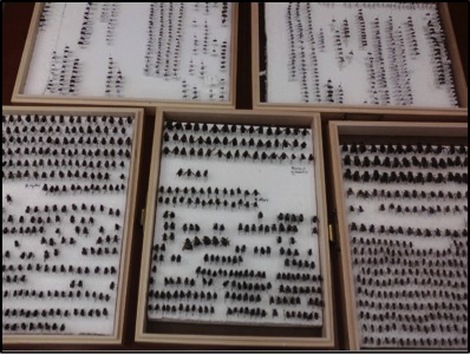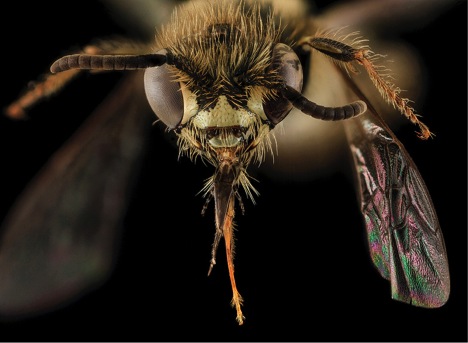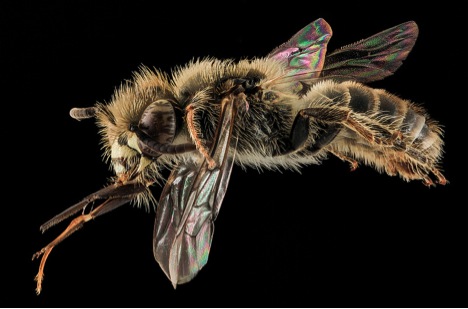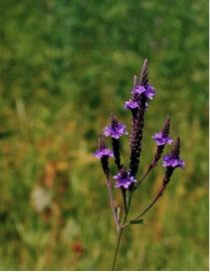|
-- Kassie Urban-Mead, Undergrad A visit today to any of my thirteen research fields today won’t yield many bees, the buzzing quieted and the whirring of wings and ferrying of nectar and pollen arrested with the frost. Yet they are there—solitary bees, mated queens, a few residual workers—nestled in soil cavities, pithy stems, and deep within piles of coarse woody debris. I stole from their midst this summer over 1,400 bees as part of my senior research—I’m in pursuit of uncovering more clues as to the landscape features and human land-use practices with the strongest effects on their community integrity. Today those guys look like this: After many hours at the microscope, I had the great privilege of meeting with Sam Droege at the USGS Patuxent Wildlife Research Center for an identification extravaganza. Sam, a great native bee expert, worked with me for two days in his teaching lab, correcting the mis-attempts and verifying the successful determinations. He regularly brings in high school students to work on the collections, and answers phone calls from novice naturalists and seasoned conservationists, journalists, and symposium directors alike. All in a day’s work! The processing goal of the bustling lab? To increase the BPM—that is, Bees Per Minute—without losing identification, pinning, or cleanliness accuracy in the specimens. Sam found two rare bees in my collection: Calliopsis nebraskensis and Triepeolus obliteratus. Neither are unheard of in CT, but neither are there many records. The photos included here are of my C. nebraskensis specimen. The photos were taken by S. Droege with a high-powered camera; his software stitches together tens images focused at slightly different depths of field into these highly resolved images. The link to the complete photostream of arthropodal majesty is here. I feel so grateful to have been able to learn from Sam for a few days, and encourage use of his guides at discoverlife.org to novices and experts alike. With my IDs verified by Sam, I’ve moved into data analysis, and will be continuing my quest for insight into the needs of our precious native pollinators. The futures of food security, native wildflower pollination, biodiversity, and continued production of truly trippy and nigh-unto-extraterrestrial photos depend on it. Until next time!
24 Comments
1/16/2023 12:26:31 pm
Excellent and very exciting site. Love to watch. Keep Rocking.
Reply
2/17/2023 01:36:34 pm
Thanks for sharing the post.. parents are worlds best person in each lives of individual..they need or must succeed to sustain needs of the family.
Reply
2/19/2023 12:07:12 pm
This article gives the light in which we can observe the reality. This is very nice one and gives indepth information. Thanks for this nice article.
Reply
After reading your article, I have a lot of concerns. I wish I had someone like you by my side. Then you will get a lot of advice. Your Post I'm so glad I got to know you through your posts. Your post helped me a lot. This is a great and very interesting blog. 메이저사이트 추천 https://small-tits.info
Reply
Denizli avukatları, Denizli şehrinde faaliyet gösteren hukuk alanında uzmanlaşmış profesyonellerdir. Teknik olarak, bir avukatın rolleri ve görevleri şunlar içerebilir:
Reply
6/14/2024 04:59:30 am
Thank you for the information , visit Banyuwangi tourism at. <a href="https://amanahtrans.my.id/">Sewa mobil banyuwangi</a>
Reply
Absolutely fantastic article! The insights are not only spot on but also incredibly enlightening. Your expertise shines through and makes a real impact. I can't wait to see more of your outstanding content!
Reply
Leave a Reply. |
Archives
November 2019
Categories
All
|




 RSS Feed
RSS Feed
